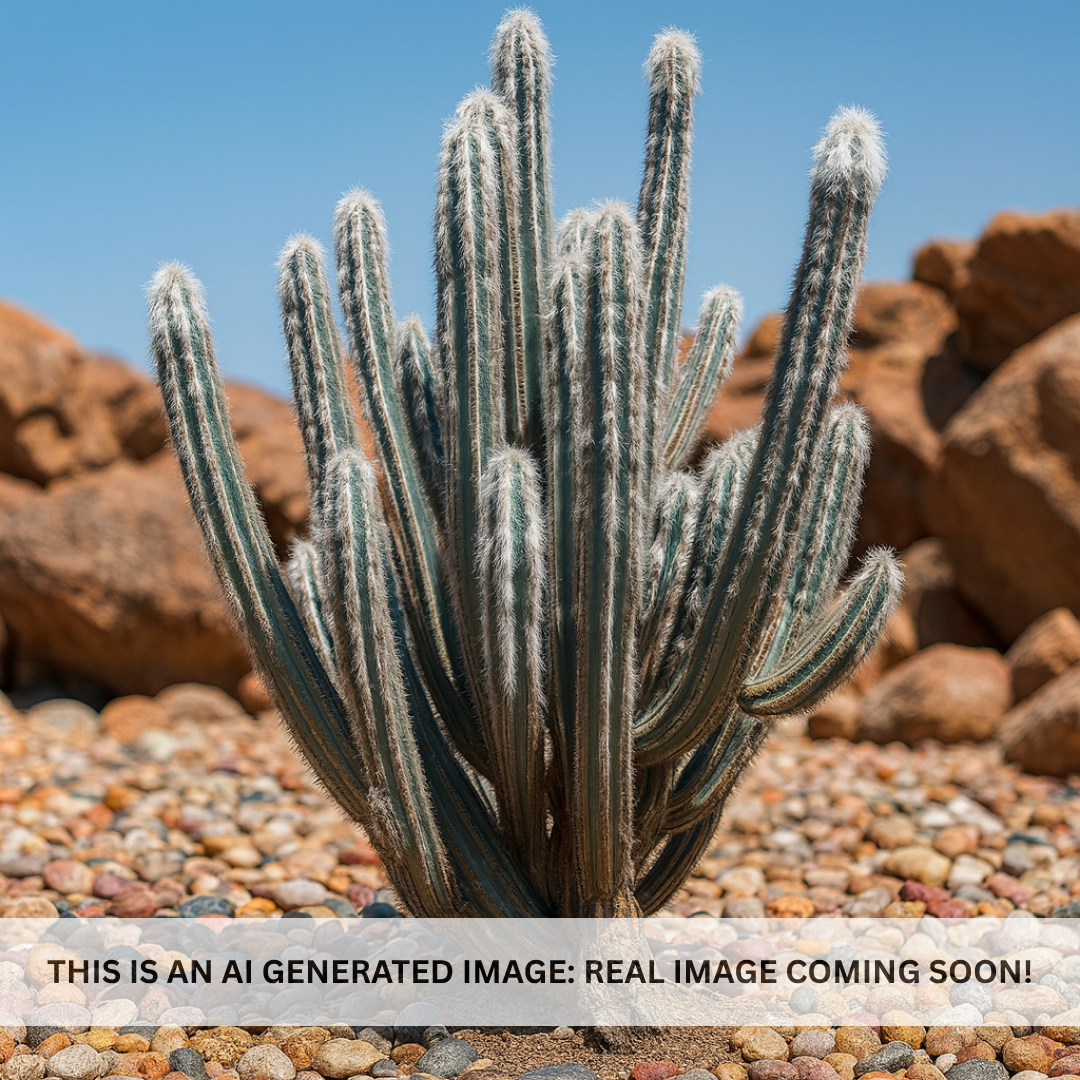My Store
Wooly Torch
Wooly Torch
Couldn't load pickup availability
Plant Type: perennial, columnar cactus**
Plant Height: 6–12 feet (can reach up to 15 feet in maturity)**
Spread: 2–4 feet
Flower Color: white (night-blooming)
Sun Exposure: Full sun
Wooly Torch / Pilosocereus palmeri: A Silvery-Blue Columnar Cactus with Elegant Desert Presence
Pilosocereus palmeri, commonly called the Wooly Torch Cactus, is a stunning columnar cactus admired for its cool blue-gray skin, golden spines, and distinctive woolly areoles that shimmer in sunlight. Native to the dry regions of Mexico, this cactus embodies both modern desert elegance and timeless architectural form, making it one of the most sought-after species for high-end Arizona landscapes.
Its upright growth, subtle color gradation, and soft halo of spines create a visual balance between strength and delicacy—making the Wooly Torch a favorite among collectors and designers alike.
Key Features of Pilosocereus palmeri
The Wooly Torch forms tall, ribbed columns with a silvery-blue epidermis and evenly spaced ribs, typically 8–12 per stem. Each rib bears clusters of short, golden to straw-colored spines, emerging from dense patches of white wool (areoles) that give the plant its signature “wooly” texture.
In late spring through summer, mature plants produce large, tubular white flowers that open at night and close by morning. These blooms attract nocturnal pollinators such as bats and moths. After flowering, red to pink fruits appear, adding seasonal interest and subtle contrast.
With time, the Wooly Torch can form multi-stemmed clumps, branching near the base or midsection, creating dramatic silhouettes that catch morning and evening light beautifully.
Growing and Care Tips
Pilosocereus palmeri thrives in full sun and excellent drainage, performing best in rocky, sandy, or decomposed granite soils. In the Phoenix Valley, it flourishes under intense sunlight and reflected heat, showing its best color when fully exposed.
During establishment, water deeply every 14–21 days depending on heat and soil drainage. Once established, water only every 4–6 weeks in summer and rarely in winter. Overwatering can cause splitting or root rot, especially in cool weather.
This cactus is cold hardy to about 25°F for short durations but should be protected from prolonged frost. Young plants may benefit from frost cloth or temporary covers during cold snaps.
Growth is moderate to fast for a columnar species under ideal conditions. Pruning is rarely needed; simply remove damaged or diseased segments with sterilized tools.
For container growth, use a tall, deep pot with a gritty cactus mix and ensure excellent drainage.
Landscaping Uses
The Wooly Torch is ideal for architectural, desert-modern, and resort-style landscapes, where its tall, elegant form and unique color provide vertical contrast and texture. Its silvery-blue columns stand out against warm desert backdrops and pair beautifully with Golden Barrel Cactus, Blue Glow Agave, or Toothless Desert Spoon (Dasylirion longissimum).
It also shines as a standalone focal point in entryways, courtyards, or rock gardens. When grouped in odd numbers, it creates a stunning rhythmic effect reminiscent of natural cactus stands in the Sonoran Desert.
Under landscape lighting, its ribbed surface and woolly texture cast soft shadows that emphasize its sculptural qualities—making it equally impressive at night.
Summary
The Wooly Torch (Pilosocereus palmeri) is a masterpiece of natural design—bold, refined, and resilient. Its silvery-blue columns, golden spines, and luminous woolly texture bring modern sophistication to Arizona landscapes. Perfect for designers and collectors seeking structure, color, and contrast, this cactus is both a showpiece and a survivor—thriving in the same harsh conditions that define the desert’s timeless beauty.
Three Timbers Installation Guide (Feel Free to Follow):
Pilosocereus palmeri Planting Guide:
Location: Full sun; choose an open, bright site with at least 8 hours of direct sunlight daily. Handles reflected heat and exposed desert conditions exceptionally well.
Soil: Use a sharply draining cactus mix blended with decomposed granite or pumice. Avoid clay-heavy or compact soils.
Spacing: Allow 4–6 feet between plants or structures for mature spread and visual balance.
Planting Depth: Keep the base level with or slightly above soil grade. Avoid burying the crown or lower ribs.
Support: Young plants may need light staking until roots establish; remove supports after stability is achieved.
Watering Guide:
Watering After Planting: Water deeply once after installation to settle the soil. Then allow it to dry fully before watering again. During the first 3–4 months, water every 14–21 days depending on heat and soil drainage.
When is the Plant Established? The Wooly Torch is considered established after 9–12 months, once color deepens and new vertical growth appears.
Watering Once Established: Water every 4–6 weeks in summer if no rainfall occurs. In winter, watering is rarely necessary.
Drip Irrigation Setup: Install one low-flow emitter (1–2 gallons per hour) about 12–18 inches from the base, angled outward. Run sparingly and always allow soil to dry between cycles.
General Watering Tips: Always confirm soil dryness before watering. Overwatering is the leading cause of decline. A top dressing of decomposed granite or gravel enhances drainage, reduces soil splash, and visually complements the cactus’s blue-gray color. Keep gravel several inches from the base for airflow and long-term plant health.
Share












